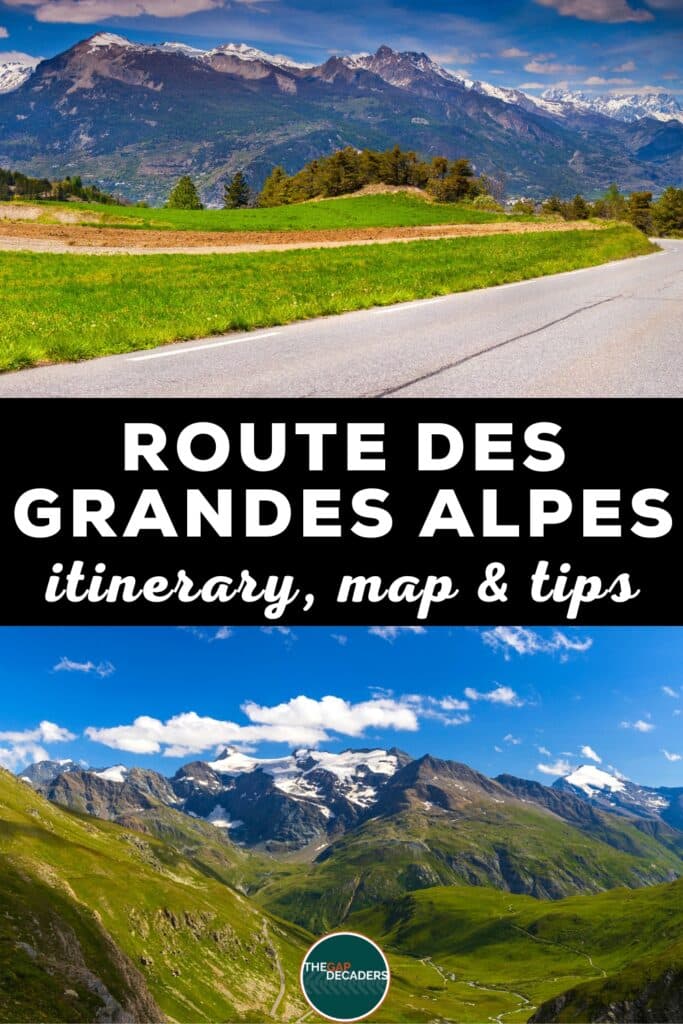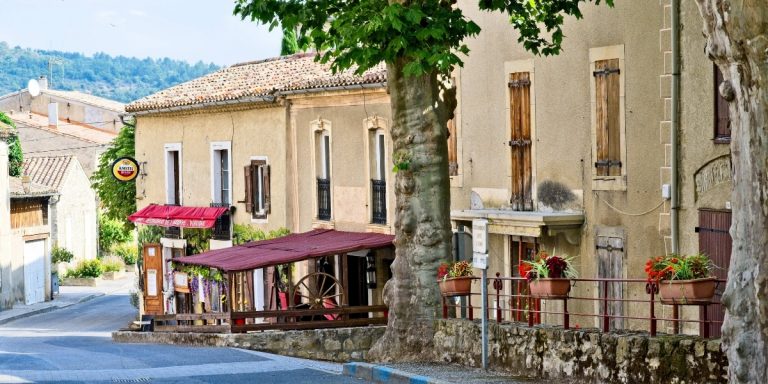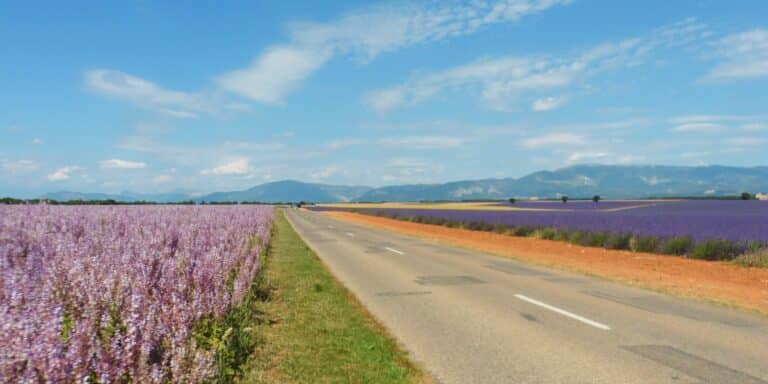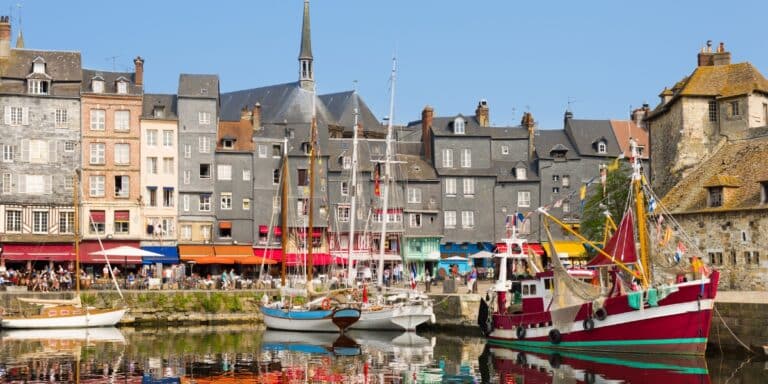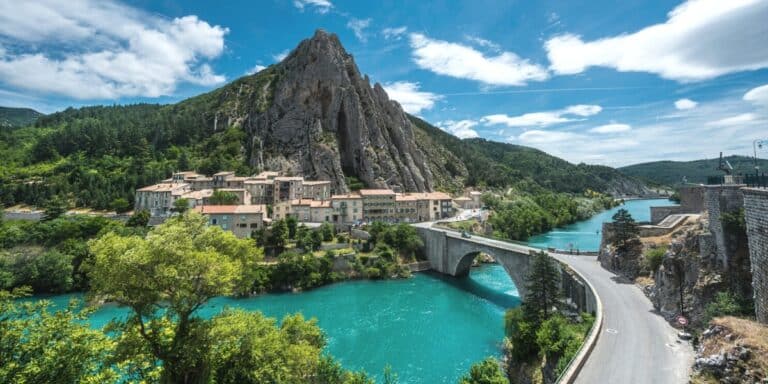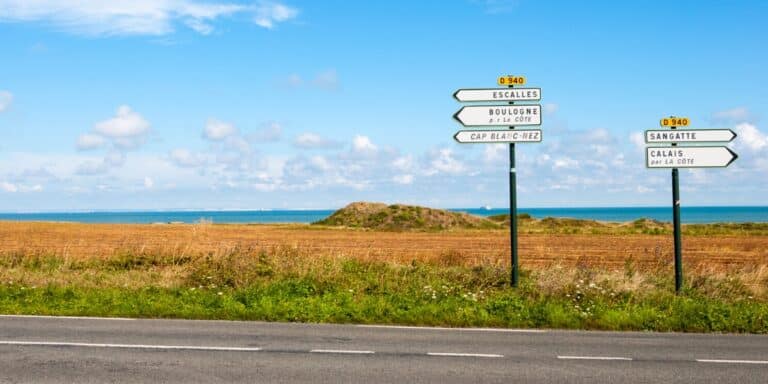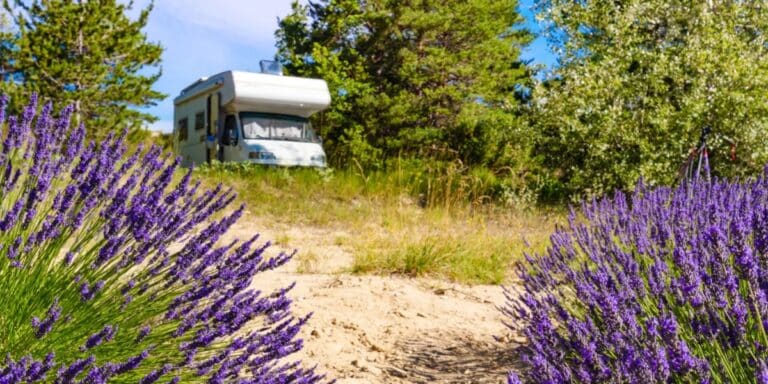This post may contain affiliate links, from which we earn an income. Click here to read our affiliate policy.
The Route des Grandes Alpes connects the Cote d’Azur with Lake Geneva and crosses the French Alps over incredible mountain passes, taking you on a truly unforgettable road trip experience.
From discovering charming lakeside towns and the dramatic Alps to tackling some of France’s best driving roads, you can also take time to stop and discover adrenaline sports, relax in a spa and sample delicious French cuisine on this road trip through Eastern France.
In this Route de Grandes Alpes road trip planner, we share travel tips, the best route between towns and cities, things to do and see along the way, and hotel recommendations to help you plan your perfect French itinerary.
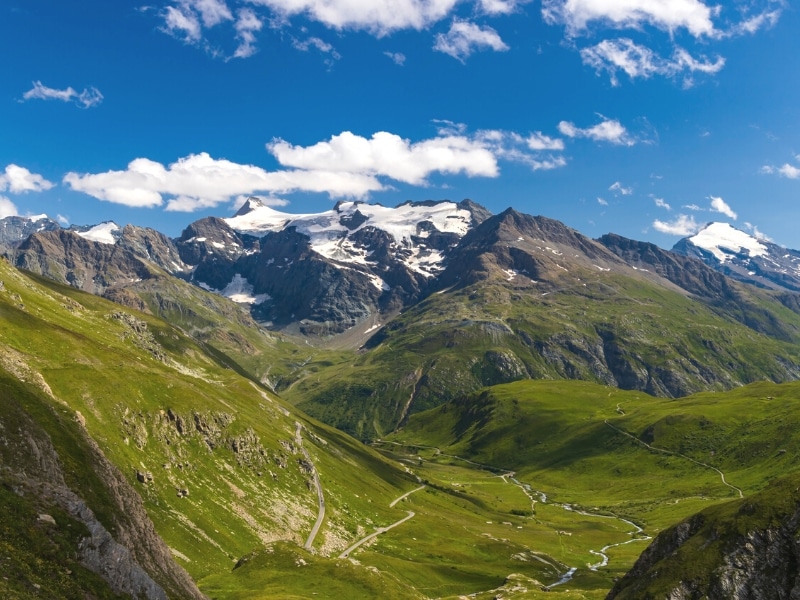
What is the Route des Grandes Alpes?
La Route des Grandes Alpes is a 447 mile / 720km tourist itinerary through the Alpes-Maritimes department in the Provence-Alpes-Côte d’Azur region in eastern France, between Lake Genèva (also known as Lac Léman) and the French Riviera.
Construction of the route started in 1909 and the road was opened in 1913, and fully paved in 1937 before being named ‘Route des Grandes Alpes’ in 1950.
The scenic drive starts in the lemon capital of Menton on the French Riviera, surely one of the most beautiful cities in France, and climbs over numerous passes including the Col de la Bonette and Col de l’Iseran, the highest and second-highest paved roads in the Alps, before ending in Thonon-les-Bains on the shores of Lac Leman.
The classic route has 17 Alpine passes, but over the years, off-shoots have been added to create a route that covers up to 23 mountain passes depending on which detour you take!
Is this your first time visiting France? Get all the information you need in our France Travel Guide, including what to pack, the best time of year to go, getting there, and practical tips to help you have the best trip!
Getting to the Route des Grandes Alpes
The Route des Grandes Alpes is a north-to-south or south-to-north road trip route. It doesn’t matter which way you travel – the views of the alpine valleys and mountains are always spectacular!
To begin in Thonon-les-Bains, fly to Geneva Airport, an hour and ten minutes drive along the beautiful shores of Lake Geneva to Thonon-les-Bains.
To start in Menton, fly into Nice Côte d’Azur Airport, an hour’s drive west along the Mediterranean coast to Menton.
Both Geneva and Nice airports enjoy direct flights from Europe, the Middle East, the UK, and Canada, meaning connections to America and the rest of the world are easy. We recommend booking through Skyscanner for live deals and the best prices.
Make sure you have travel insurance you can trust when visiting France. We recommend True Traveller for their 5-star TrustPilot reviews, variety of cover options, best activities cover as standard, great prices, and excellent service.
How to Travel the Route des Grandes Alpes
Self-Drive
Whether you’re in a car, motorcycle, campervan, or motorhome, driving is absolutely the best way to explore the Route des Grandes Alpes, meaning you can stop whenever you want, try new activities, visit places you see along the route, and have the freedom to change plans at the last minute.
Are you planning to rent a car in France? As one of the largest car hire aggregator companies in the world, we recommend Rentalcars.com because they have massive purchasing power which enables them to secure the best rental prices, which benefits you when you’re planning a road trip.
For a real adventure, hire a motorhome or campervan in France. We recommend Motorhome Republic, an aggregate booking site who pull together all the best deals from a number of rental agencies, to offer you a wide choice of options alongside an excellent English speaking expert motorhome Concierge Team.
Use the Park4Night app to find overnight spots and campsites, and sleep on a high mountain pass, next to a beautiful lake, or in a wildflower meadow.
The Route des Grandes Alpes by Public Transport
You don’t need to have a car, motorbike, or campervan to access this incredible road. It is possible to cover the whole route using a combination of trains with an e-bike, or in French vélo à assistance électrique.
There are SNCF stations along the route at Menton, Montdauphin-Guillestre, Briançon, Oulx, Saint-Michel-Valloire, Bourg-Saint-Maurice, Annecy, Cluses, and Thonon-les-Bains, allowing you to move easily between stages of the route and pick which passes you want to ride over – or you could just do the whole route!
To tackle this route you’ll need a battery capacity of at least 500Wh and a central motor (as opposed to a hub motor) for the highest range.
There are plenty of hotels, restaurants, cafés, bike shops, food stores, and tourist offices that offer free charging along the route.
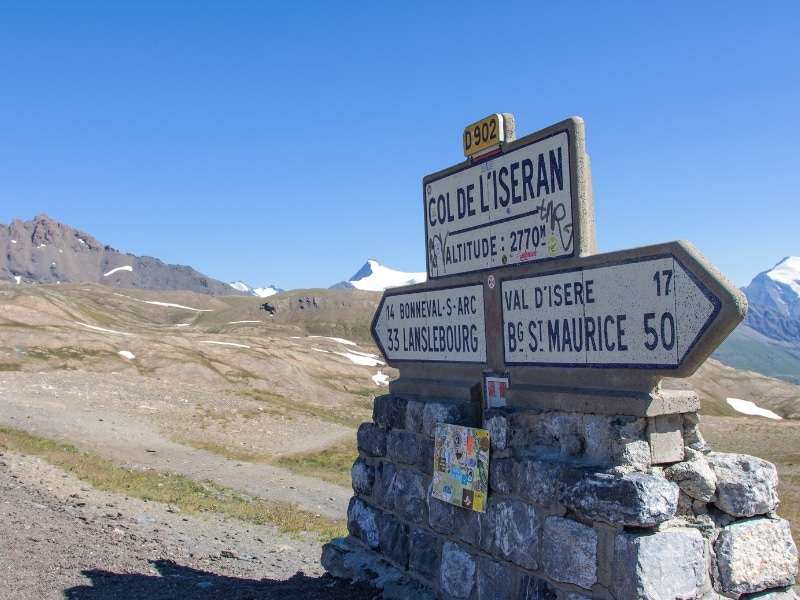
Is the Route des Grandes Alpes a Dangerous Road?
The various roads that make up the Route des Grandes Alpes are all paved and the quality of the road surface is generally good, meaning you can drive and cycle the route comfortably.
Some of the mountain passes have switchbacks and hairpin bends on both ascents and descents and should be driven with caution. As with all mountain driving, use the gears to help with speed on the descent and pump the brakes instead of riding them, and use a low gear when climbing and negotiating tight turns.
An inexperienced driver may find some of the mountain roads challenging, especially where the road is narrow and has no central markings, and some passengers may find the sheer vertical drops a tad disconcerting!
RELATED POST: Driving in the Alps: Top Tips & Best Routes
Looking for the best SIM card deals in Europe for your trip? Check out our guide to the best data SIMs in Europe and get the best deal for your trip to France.
When is the Best Time to Visit the Route des Grandes Alpes?
There really is only one window to road trip the Route des Grandes Alpes!
The route is fully open between June, after the snows have gone, and October. Most of the passes are open at the end of May, but a handful of the highest are clear and open only after mid-June at the earliest.
Keep an eye on the weather if you’re planning to drive the route in early June and from mid-October, as the weather can change rapidly and be unpredictable in the mountains during the shoulder seasons.
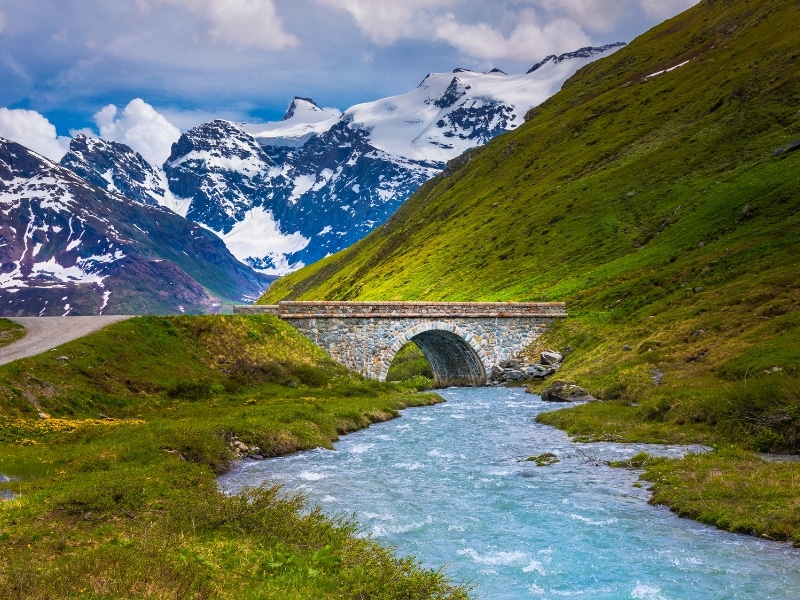
Route des Grandes Alpes Map & Route
Menton – Sospel – St Martin-Vésubie – Valberg – St Étienne-de-Tinée – Barcelonnette – Guillestre – Briançon – Valloire – Val-Cenis – Val-d’Isère – Bourg-Saint-Maurice – Beaufort – Le Grand-Bornand – Thonon-Les-Bains
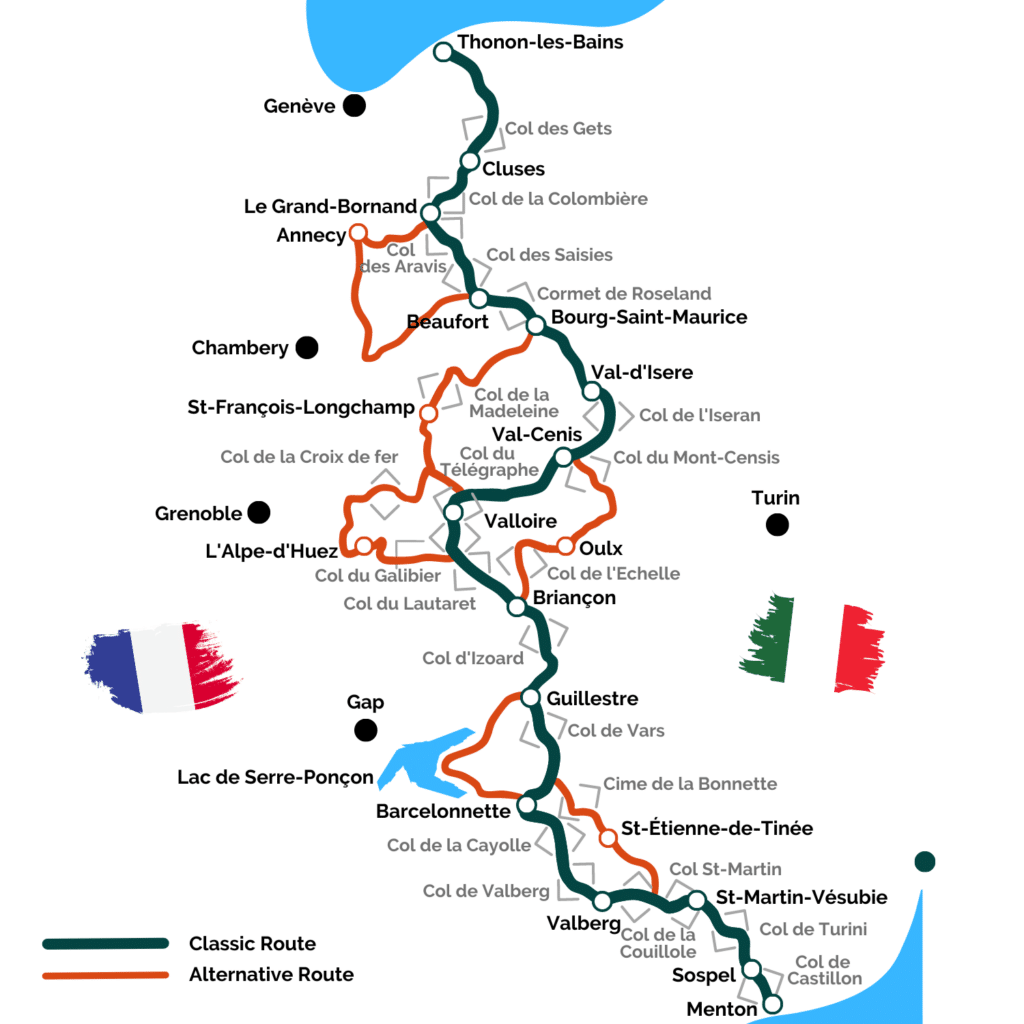
Route des Grandes Alpes Itinerary
Day 1: Menton to Sospel
The starting point of the Route des Grandes Alpes at zero kilometers is marked with an engraved plaque in the pavement on Esplanade Francis-Palmero opposite the market in Menton. From here take the D2566 out of town.
Menton
Menton is a beautiful town on the French Riviera, close to the border with Italy. Known for its mild climate, colorful architecture, and stunning natural surroundings, Menton is a good place to spend a day before starting your road trip.
There are many things to do in Menton, including exploring the town’s historic center, which is filled with narrow streets, and charming squares where you can shop for local crafts and souvenirs, and sampling the delicious local cuisine, which features fresh seafood, olive oil, and other Mediterranean flavors.
One of the most popular attractions in Menton is the Basilica of Saint Michael the Archangel, a stunning church that dates back to the 17th century. The town is also home to several museums, including the Jean Cocteau Museum, which showcases the works of the famous French artist.
Col du Castillon
Today you’ll be driving the first pass in the southern Alps, the Col du Castillon at 2,306 feet / 703 meters, tackling at least ten switchbacks and crossing the historic viaducts of Viaduc du Caréï and Viaduc du Caramel.
Sospel
Start by exploring the streets of the old town of Sospel, lined with well-preserved stone buildings, historic houses, and the beautiful 12th century Romanesque-style Cathedral of Saint Michael, also known as Sospel Cathedral. It features stunning architectural details, including a rose window, frescoes, and a beautiful wooden altarpiece.
Northeast of the cathedral is Pont Vieux, or Old Bridge, a medieval stone bridge that is a significant historical landmark crossing the Bevera River.
Visit the Mount Agaisen Fortress just outside the town center. It is a World War II hilltop bunker that was an extension of the Maginot Line, and a strategic position during the battle for Nice. The bunker has been lovingly restored and maintained by a group of locals.
In the Sospel town center, head to Sousper or Le Picoun for delicious pizza.
Upmarket: La Chapelle Saint Gervais – Booking.com | Agoda
Mid-Range: Domaine du Paraïs B&B – Booking.com | Agoda
Budget: Camping le Mas Fleuri – Booking.com | Agoda

Day 2: Sospel to St Martin-Vésubie
From Sospel continue north on the D2566, making sure to stop at Notre Dame de la Menour. A historic monument located on a ridge in the mountain, the church is accessed by a long path and staircase. It is the perfect spot to take a moment away from the road and contemplate the glorious landscape which surrounds the tiny church.
Col de Turini
The Col de Turini at 5,272 feet / 1,607 meters is notorious for its narrow roads and many hairpins bends and is the technical centerpiece of the annual Monte Carlo Rally.
Until recently, racing drivers drove up the Col de Turini at night as thousands of fans watched the ‘night of the long knives’, so-called due to the strong high beam headlights cutting through the night.
The Col de Turini featured in the E1 S10 of Top Gear when Jeremy Clarkson, Richard Hammond, and James May went in search of the greatest driving road in the world – so you’re in good company!
St Martin-Vésubie
The picturesque village of St Martin-Vésubie is in the Mercantour National Park, one of France’s ten national parks, and home to the Church of Saint Martin, which dates to the 1600s and features beautiful baroque-style decorations.
Pop into Le St Mart’ for delicious local wine or La Treille for dinner on the terrace.
Upmarket: Pure Montagne Resort and Spa – Booking.com | Agoda
Mid-Range: La Bonne Auberge – Booking.com | Agoda
Budget: La Ribambelle – Booking.com | Agoda
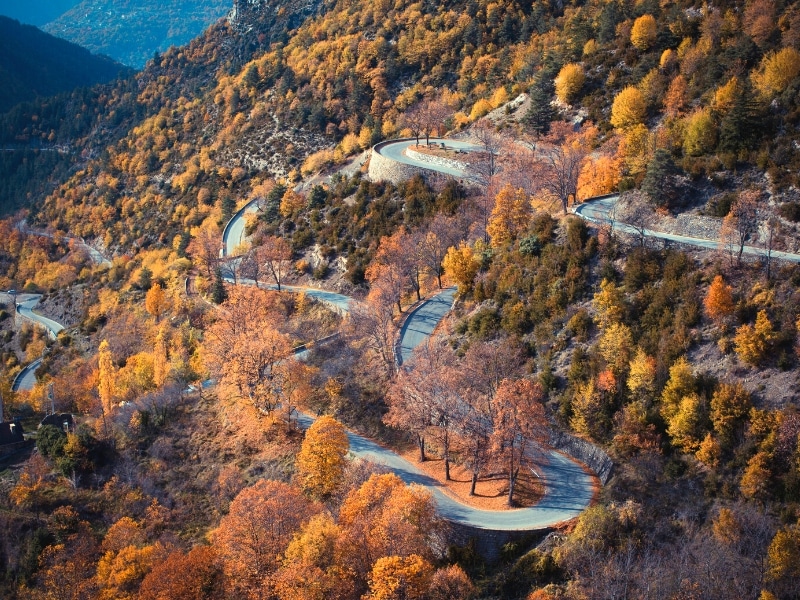
Don’t forget your road trip essentials! Our free road trip checklists help you remember everything, including road trip snacks, podcasts, and road trip songs for the journey!
Day 3: St Martin-Vésubie to Barcelonnette
Col St-Martin
Shortly after leaving St Martin-Vésubie on the D2205, you’ll start the climb to Col Saint Martin, also known as Col Colmiane, at 4,921 feet / 1500 meters above sea level. The pass is 10 miles / 16km long with a 100-meter stretch where the gradient is a very steep 14.3%.
Once over the pass, keep your eyes peeled for Fort de la Frassinéa, a part of the Maginot Line built right next to the road. You can tour the inside of the fort to see how troops lived during the war when their sole purpose was to stop the intrusion of Italian tanks into France.
About 3.5km beyond the fort and past the small village of Saint-Sauveur-sur-Tinée is a fork in the road. The left fork takes the M30 road to Barcelonnette along the classic route, and the right fork takes the M2205, also to Barcelonnette, but takes in the Cime de la Bonette, the highest paved road in the whole of the Alps mountain range.
The Classic Route
Col de la Couilloe
At 5,505 feet / 1,678 meters above sea level, the Col de la Couilloe provides amazing views of the road.
There are a few short tracks leading from the col for a quick leg stretch and a restaurant for coffee or lunch.
Valberg
Make a stop in Valberg to ride the summer toboggan or take the short drive up to Col du Maty and Lac Lac du Sénateur, an artificial lake, for spectacular views.
Col de Valberg
It’s a fairly gradual climb up to Col de Valberg at 5,486 feet / 1,672 meters elevation. You’ll probably pass a few road cyclists on the way.
Col de la Cayolle
Considered one of the most spectacular French balcony roads, the route to the Col de la Cayolle, at 7,673 feet / 2,339 meters, is breathtaking.
The D2202 is narrow with a maximum gradient of 10% and can be busy in summer. A section of the road north of the pass through Gorges du Bachelard is a rocky canyon featuring waterfalls, stone bridges, and vertical cliffs.
The Alternative Route
St Étienne-de-Tinée
St Étienne-de-Tinée is a picturesque village well worth a wander, with a pretty Mairie and the beautiful Eglise Saint Etienne, with impressive Gothic architecture, intricate carvings, and stunning stained-glass windows.
There are a few places in the village to stop for coffee or a cold drink to break the drive.
Col de la Bonette
Col de la Bonette is one of the most famous mountain passes in the French Alps, supposedly being the highest paved road pass in Europe at 9,209 feet / 2,807 meters.
Supposedly, because it’s actually not true! Do a quick Google search and you’ll find there is a higher paved road in Europe. The Pico de Veleta in Spain is tucked away between the Sierre Nevada mountains and Almeria, and tops out at a considerably higher 3,369 meters / 11,053 feet.
Col de la Bonette is still one hell of a road though! As you climb high into this alpine pass you are treated to panoramic views of the surrounding mountains, valleys, and glaciers.
The Cime de la Bonette is the highest point of the Col de la Bonette. From the summit, you can enjoy a breathtaking 360-degree view of the surrounding landscape and the glistening Mediterranean Sea in the distance.
The Fort de la Bonette, a military fortress that was built during World War II, is perched on a rocky outcrop overlooking the Col de la Bonette and offers a glimpse into the history of the region.
Barcelonnette
Barcelonnette is a charming town located in the Ubaye Valley, boasting a well-preserved old town with narrow streets, colorful houses, and historic buildings that date back to the 17th and 18th centuries. This is because most of Barcelonnette was ruined by a fire in 1628, after which major rebuilding happened.
Barcelonnette is a typical mountain town, with outdoor clothing shops, cute cafés, and plenty of bars in the old town. There are even a couple of spas if you need a break from driving!
In the town center, you can visit the Museum of the Valley, which showcases the unique history and culture of the Ubaye Valley including the strong connections the region has with its near neighbor Italy.
Thrill seekers can get their adrenaline pumping with water sports such as white-water rafting, kayaking, and canoeing on the Ubaye River, known for its exciting rapids and stunning scenery.
After a long day, dine at Le Tinto for a lively atmosphere and French classics, or Ô tadem for delicious homemade dishes and cocktails.
Upmarket: Villa Morelia, Jausiers – Booking.com | Agoda
Mid-Range: Le Grand Hotel – Booking.com | Agoda
Budget: Hôtel Du Cheval Blanc – Booking.com | Agoda
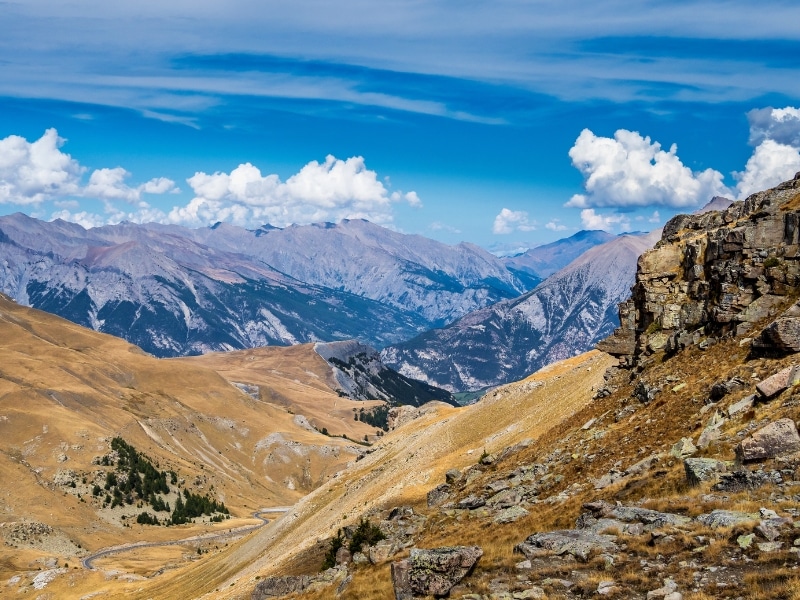
Day 4: Barcelonnette to Briançon
The classic route from Barcelonnette takes you across Col de Vars and the magnificent Col d’Izoard, but if you fancy a rest day, take an easy drive on the alternative route and spend a day relaxing around Lac de Serre-Ponçon, a delightful glacier-fed lake perfect for swimming and water sports.
Col de Vars
The Col de Vars is located between the departments of the Hautes-Alpes and the Alpes de Haute-Provence and connects the Ubaye Valley with the Queyras. It reaches a height of 6,926 feet / 2,111 meters above sea level.
The twisting D902 8 miles / 13km long road to the summit is totally paved and is quite an easy drive. Look out for the Fort de Tournoux, built in 1843 to defend France from invasion by the Italians.
Guillestre
Located at the gateway to Queyras Regional Nature Park between the Vars and Izoard passes, Guillestre possesses a beautiful religious heritage.
The 13th century Fort Queyras offers panoramic views of the surrounding mountains and Queyras Valley and you can explore its walls, towers, and ramparts and learn about its fascinating history.
Afterward, visit the beautiful 16th century Church of Saint Andre to admire its stunning architecture and artworks.
A short drive from Guillestre town center is the La Durance Fromagerie. Visit this dairy farm to learn about the cheese-making process and purchase excellent local products, including cheeses, pestos, sausages, pâtés, and wine.
Guillestre also offers numerous mountain climbing routes suitable for all levels of experience. Whether a beginner or an experienced climber, you can take some time away from the road and enjoy the thrill of climbing stunning mountain landscapes.
Enjoy lunch at La Bolee or the quirky but excellent Le Galet Chez Jacquie et Fifi.
Col d’Izoard
The Col d’Izoard tops out at 7,743 feet / 2,360 meters, making it the fifth-highest mountains pass on the Routes des Grandes Alpes.
On the upper south side are harsh and barren scree slopes with protruding pinnacles of weathered rock. Known as the Casse Déserte, which literally translates as ‘deserted scrapyard’, this area has formed a dramatic backdrop to some key moments in the Tour de France.
At the top is a memorial to Fausto Coppi, the dominant international cyclist of the post-WWII years, and Luison Bobet, the first rider to win the Tour de France in three successive years.
Briançon
Briançon is a picturesque town known for its well-preserved Fortifications of Briançon, recognized as a UNESCO World Heritage Site. Some of the sites to visit are Fort des Trois Têtes, Fort du Randouillet, Fort du Château, and Fort des Salettes.
Enjoy a stroll through the streets of Briançon’s old town to admire the architecture, and visit attractions like the Church of Notre-Dame-et-Saint-Nicolas before hopping on the Prorel Cable Car, which offers panoramic views of the surrounding mountains. It’s a great way to enjoy the breathtaking alpine scenery and take in the beauty of the Briançon area.
Afterward, visit the thermal baths of Les Grands Bains du Monêtier. You can relax and rejuvenate in the mineral-rich thermal waters while enjoying the stunning mountain views.
Dine at Le Gavroche for traditional mountain cuisine or Le Pied de la Gargouille for excellent barbequed food.
Upmarket: Hôtel Restaurant de la Chaussée – Booking.com | Agoda
Mid-Range: Hôtel Vauban Briançon Serre Chevalier – Booking.com | Agoda
Budget: Auberge de la Paix – Booking.com | Agoda

Want to plan your own road trip? Get our step-by-step road trip planning guide to help you organize the perfect trip, or check out our Europe road trip ideas.
Day 5: Briançon to Val-Cenis
Straight out of Briançon, you are faced with three options;
- The classic route crosses the Cols of Lautaret, Galibier, and Télélgraphe and passes through Valloire.
- The alternative route west crosses the Cols of Lautaret and Croix de fer and visits the Alpine resort of L’Alpe-d’Huez.
- The alternative route east crosses the Cols of l’Echelle and Mont-Censis and visits the only town on the route in Italy, Oulx.
The Classic Route
Col du Lautaret
Col du Lautaret is a high mountain pass at 6,752 feet / 2,058 meters and marks the boundary between the valleys of the Romanche and the Guisane, a tributary of the River Durance which has its source at the Col.
The route is a steady gradient with an average of 3.8% and the treeless landscape gives fantastic views of the road ahead and Grand Pic de la Meije, the second-highest mountain of the Écrin range at 13,068 feet / 3,983 meters.
Remarkably, there is a botanical garden even higher than the pass! The Lautaret Alpine Garden is a two-hectare alpine botanical garden located at 2,100 meters altitude, just beyond the Col. Managed by the Université Grenoble Alpes, the garden is home to more than 2,300 species of alpine plants from around the world and a herbarium of 15,000 plants collected over the last 150 years.
Col du Galibier
The eighth-highest paved road in the Alps and often the highest point on the Tour de France cycle race, Col du Galibier tops out at 8,668 feet / 2,642 meters.
Located between the massif d’Arvan-Villards and the massif des Cerces, the Col takes its name from the secondary chain of mountains known as the Galibier.
Historically, a tunnel was the only route at the top, at an altitude of 8,386 feet / 2,556 meters, but the tunnel was closed for restoration in 1976 and a new road was constructed over the summit.
The tunnel reopened in 2002 as a single lane controlled by traffic lights and is amongst the highest such installations in Europe. If you want to drive through the iconic 365m Tunnel du Galibier, your vehicle must be under 19 tons, no wider than 3.2 meters, and no higher than 4.1 meters.
At the south entrance to the tunnel, there is a memorial to the so-called father of the Tour de France, Henri Desgrange, who started the cycle race in 1903. He loved the Col du Galibier and once wrote “In front of this giant we can do nothing but take our hats off and bow” – how right he was.
Valloire
Valloire is a famous ski resort town with beautiful mountain scenery and much to offer visitors in summer.
You can take time out from your road trip and explore the breathtaking alpine scenery by hiking one of the several trails or enjoy a paragliding adventure. Experienced pilots can take you on a tandem flight, allowing you to experience the thrill of flying without prior experience.
In town, visit the Notre Dame de l’Assomption Church, known for its beautiful Baroque-style church, and find the Vegetal Sculpture, a living statue made of plants that change with the seasons.
Enjoy lunch at La Poutre or L’Asile des Fondues for delicious cheese fondue, a typical local dish.
Col du Télélgraphe
Located in the Cerces massif and a much lower pass than the previous two, the Col du Télégraphe has an altitude of 5,138 feet / 1,566 meters, and the Fort du Télégraphe, after which the pass is named, takes full advantage of its strategic position above the Maurienne Valley.
Originally a Chappe telegraphy station located on the line from Lyon to Milan, the construction of the fort was carried out between 1886 and 1890 and belongs to the Séré de Rivières system. It’s well worth a visit in summer when activities, tours, and other events take place.
The Alternative Route West
Col du Lautaret
Col du Lautaret is a high mountain pass at 6,752 feet / 2,058 meters and marks the boundary between the valleys of the Romanche and the Guisane, a tributary of the River Durance which has its source at the Col. See above for more information.
L’Alpe-d’Huez
L’Alpe-d’Huez is a beautiful mountain resort town located in the French Alps. It is a popular destination for skiing and snowboarding in the winter, but there are also plenty of things to do in the summer.
One of the main attractions in L’Alpe-d’Huez during the summer is the stunning scenery. The town is surrounded by snow-capped peaks and lush green valleys, which make it a perfect destination for hiking, mountain biking, and other outdoor activities.
Try the summer sledge on rails, Luge des Bergers, which hurtles down the mountain for a kilometer, take a swim in one of the municipal pools or join a guided walk.
In addition to outdoor activities, L’Alpe-d’Huez also has a number of cultural attractions. The town is home to several museums and galleries, which showcase the history and culture of the region. Visitors can also explore the L’Alpe-d’Huez market and shops, which offer a wide range of handmade crafts and souvenirs.
Col de la Croix de fer
Formerly called Col d’Olle because of its location at the source of Eau d’Olle, the mule track which took the pass for several centuries was finally transformed into a road in 1912 when it became Col de la Croix de fer after an iron cross was placed on the pass.
With an altitude of 6,775 feet / 2,065 meters, the pass is situated between the alpine massifs of Grandes Rousses and Arves, and enjoys a steady traverse up past the sparkling Barrage de Grand’Maison, before passing a number of hairpin bends on a narrow road on the way down.
The Alternative Route East
Col de l’Echelle
The Col de l’Échelle, or Ladder Pass, reaches an altitude of 5,781 feet / 1,762 meters above sea level. Located in the Hautes-Alpes department, the pass is just 3.7 miles / 6km from the border with Italy, and you’ll cross into the country on the way down.
Oulx
Located in the Susa Valley in the Piedmont region of Italy, Oulx has a rich history that dates back to the Roman times when the town was strategically located on the Roman road that connected Italy to Gaul, now modern-day France.
The neighboring town of Sauze d’Oulx is a hive of activity in summer, with hiking, mountain biking, road cycling, golf, and Via Ferrata on offer.
Col du Mont-Censis
Just after Moncenisio, you’ll cross back into France on the SS25, which becomes the D1006. Shortly after, you’ll drive past Lac du Mont-Censis as you begin the ascent to Col du Mont-Censis.
The pass tops out at 6,840 feet / 2,085 meters over the Mont-Censis massif, which forms the border between the Cottian Alps and the Graian Alps.
Mont Cenis was one of the most used Alpine passes from the Middle Ages to the nineteenth century, and for much of that time, the pass straddled France and Italy. It is known that pilgrims used this route on their journey to Turin, and some historians believe that it was the Col du Mont-Censis that Hannibal used to cross the Alps in 218 BCE.
Val-Cenis
Val-Cenis is a beautiful ski resort with plenty to offer once the snow has melted!
In summer, you can enjoy breathtaking views of the surrounding peaks with a tandem paragliding flight. If you prefer a land-based activity, you can challenge yourself to one of several mountain biking trails to admire the area’s scenic beauty.
After an active day outdoors, relax at Les Massages de Laurent – Bien Être et Soins spa center. Enjoy a massage, sauna, or other wellness treatments to rejuvenate your body and mind.
For dinner head to Le Sabot De Venus for traditional mountain dishes or La Petite Ferme for pizzas and burgers.
Upmarket: Résidence Les Balcons De Val Cenis Le Haut, Lanslevillard – Booking.com | Agoda
Mid-Range: L’Outa Hotel – Booking.com | Agoda
Budget: Auberge La Turra – Booking.com | Agoda
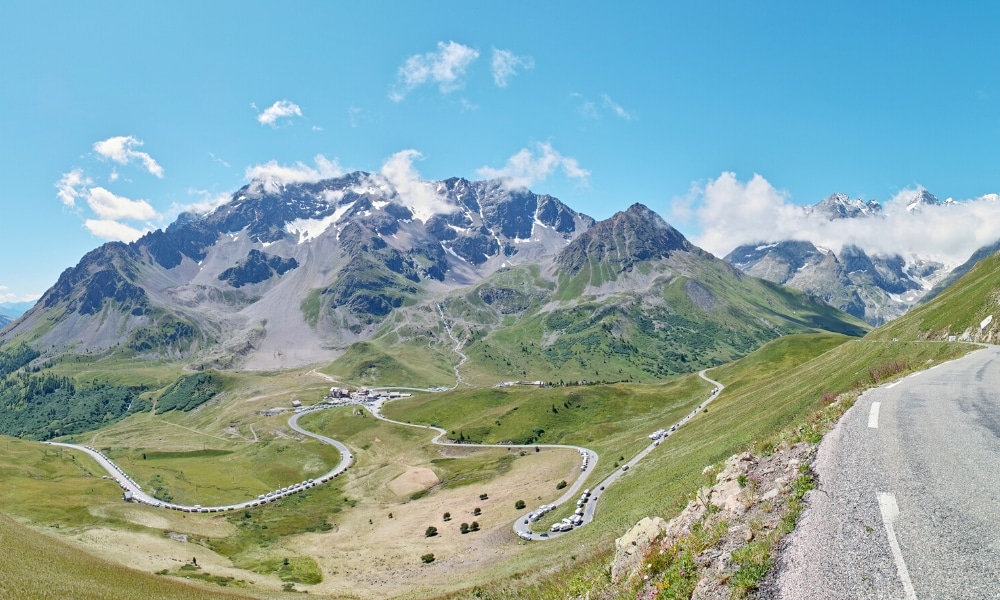
Day 6: Val-Cenis to Bourg-Saint-Maurice
From Val-Censis, you can take the classic route north to the Col de l’Iseran and Val d’Isere, or head west and take the alternative route to St-François-Longchamp and the Col de la Madeleine.
The Classic Route
Col de l’Iseran
At an elevation of 9,068 feet / 2,764 meters, the mighty Col de l’Iseran is the second-highest paved pass in the Alps and offers breathtaking views of the surrounding mountains and valleys of the Graian Alps. It’s no surprise that this road is known as ‘the king of the Alps’.
The scenic drive along the Col de l’Iseran will allow you to explore the nearby nature reserves, including the Vanoise National Park and the Grande Sassière Nature Reserve. These protected areas are home to a diverse range of flora and fauna and offer opportunities for hiking, wildlife watching, and experiencing the natural beauty of the region.
For those interested in history and culture, Col de l’Iseran offers several interesting landmarks and monuments. These include the Baroque-style church in Bonneval-sur-Arc, which dates back to the 17th century, and the Fort Saint-Gobain, a historic military fort located near the pass.
Val-d’Isère
Val-d’Isère is another renowned ski resort located in the French Alps and In the summer offers many hiking trails to explore the stunning landscapes and Alpine flora. From leisurely walks to more challenging hikes, there are options for all fitness levels.
At the Parc des Sports du Manchet you can enjoy tennis, horse riding, golf, archery, and pétanque, Le Centre Aquasportif has hot tubs and saunas, and the Bike Park Tignes-Val d’Isère offers downhill, cross country, and enduro routes and even has a gourmet route where you can stop for a taste of local cuisine along the way – only in France!
The village is full of charming, narrow streets and traditional chalets and you can take a cultural tour to discover the village of Val d’Isère and its 17th-century buildings and the unspoiled hamlet of Le Fornet. Alternatively, hire an electric scooter and explore at your own pace.
The Alternative Route
St-François-Longchamp
A pretty off-the-beaten-path French town in the Savoie region, St-François-Longchamp makes a great place to stop for a traditional Savoyard dish for lunch – think fondue, raclette and tartiflette – and a leg stretch.
With nearby lakes, short hiking trails, a summer toboggan, high ropes course, and a balneo spa, you could even be tempted to stay a little longer!
Col de la Madeleine
One of the symbolic French Alps mountain passes, Col de la Madeleine is a high mountain pass at an elevation of 6,555 feet / 1,998 meters above sea level, and is 23 miles / 37km long and a tough climb – on a bike that is!
The Col de la Madeleine has been in use since Roman times and the decision to build the current paved road was taken in 1949 and the inauguration took place in 1969. The summit offers a stunning panorama of Mont Blanc and the Lauzière massif.
Bourg-Saint-Maurice
Bourg-Saint-Maurice is a picturesque town in the Tarentaise Valley and home to the Vanoise Express, the largest cable car in the world. It’s double-decker cabins can carry up to 200 people and connect Les Arcs and La Plagne, with stunning panoramic views of the surrounding mountains on the ride.
If you’re looking for an adrenaline-pumping adventure, try white-water rafting on the Isère River, as you navigate the rushing waters on a thrilling ride down the rapids.
If you prefer a slower pace, swap the river rafting for a round of golf at the Les Arcs golf course. Afterward, enjoy a traditional dinner at Le Refuge Altitude 810 or head to Le Chalet for fantastic home cooking.
Upmarket: Montagn’Arcs – Booking.com | Agoda
Mid-Range: Base Camp Lodge Hotel – Booking.com | Agoda
Budget: La Case à Kio, Les Chapelles – Booking.com | Agoda
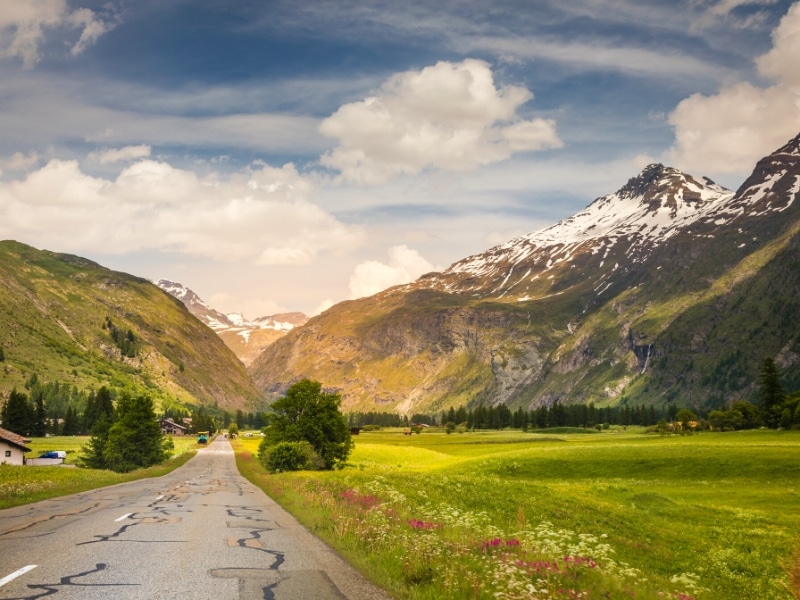
Day 7: Bourg-Saint-Maurice to Le Grand-Bornand
Cormet de Roseland
Straight out of Bourg-Saint-Maurice, you’ll hit the Cormet de Roseland overlooking the pretty Lac de Roselend, at 6,453 feet / 1,967 meters above sea level.
Make sure to stop and see the Chapelle de Roselend which was built to replace a nearby 13th century chapel that was submerged when the dam was flooded in 1960.
Beaufort
Beaufort is a small town known for its scenic beauty and delicious Beaufort cheese. You can visit the Beaufort Cheese Cooperative to learn about cheese-making and sample different varieties of the town’s famous Beaufort cheese as well as buying some to take home as a delicious Alpine souvenir.
The old town is pretty with traditional chalets and historic buildings, in particular the Church of Saint Joseph, a beautiful baroque church with stunning architecture, an ornate interior, and beautiful stained glass windows.
Boulangerie Pâtisserie Pouilloux is a good place to stop for coffee and delicious pastries to sustain you through the drive!
From Beaufort, you can head north on the classic route for the Col des Saisies and Col des Aravis, or take the alternative route to beautiful Annecy.
The Classic Route
Col des Saises
The Col des Saisies peaks at 5,436 feet / 1,657 meters and is delimited by the peak of Bisanne to the west and by the peaks of Légette and Chard du Beurre to the east. The ski resort of Les Saisies is situated on the pass.
Col des Aravis
The Col des Aravis connects the regions of Haute-Savoie and Savoie and is crossed by the Tour du Mont Blanc hiking route. At 4,879 feet / 1,487 meters, it is the lowest pass in the Aravis Range of mountains.
Don’t miss the Cascade du Dard in the Vallée de Chamonix before you start the snaking climb which starts at La Giettaz. Located in the woods close to the roa, the 66 feet / 20 meter waterfall comes from the meltwater of the Pélerins glacier and makes a refreshing and cool break from the route.
The Alternative Route
Annecy
One of the most beautiful towns in France, Annecy is known for its crystal-clear lake, stunning mountain views, and atmospheric old town that is a maze of cobbled streets, canals, and colorful buildings, with plenty of cafés, restaurants, and shops to explore.
Don’t miss visiting the Château d’Annecy, a medieval castle in the heart of the old town. A tour offers a glimpse into the town’s rich history and houses a museum of regional art and history.
Lake Annecy is one of the cleanest lakes in Europe and offers a range of water activities such as swimming, paddleboarding, kayaking, and sailing, and the surrounding mountains offer numerous hiking and biking trails, ranging from easy to challenging, with breathtaking views of the lake and the Alps.
Annecy is also one of the best places in the world for paragliding, with many schools and companies offering tandem flights for beginners, and if you like extreme sports you can also try canyoning and Via Ferrata locally.
Le Grand-Bornand
Le Grand-Bornand is a charming mountain village located in the Haute-Savoie region and one of the birthplaces of reblochon, a cheese produced from cows raised on Crau hay, grown only at the confluence of the Durance and Rhône rivers.
In the town, explore the Musée du Patrimoine or Heritage Museum to learn about the mountains’ local history, traditional crafts, and way of life, and visit the Church of Saint-Jean-Baptiste. It is a beautiful baroque church located in the heart of Le Grand-Bornand. Admire its stunning architecture, ornate interior, and beautiful stained glass windows.
Enjoy dinner at the lovely Aux Aravis or Restaurant La Bournerie for delicious French cuisine.
Upmarket: Chalet-Hôtel Inarpa, La Clusaz – Booking.com | Agoda
Mid-Range: Chalet-Hôtel Les Fermes de Pierre and Anna – Booking.com | Agoda
Budget: La Marmotte qui Papote – Booking.com | Agoda
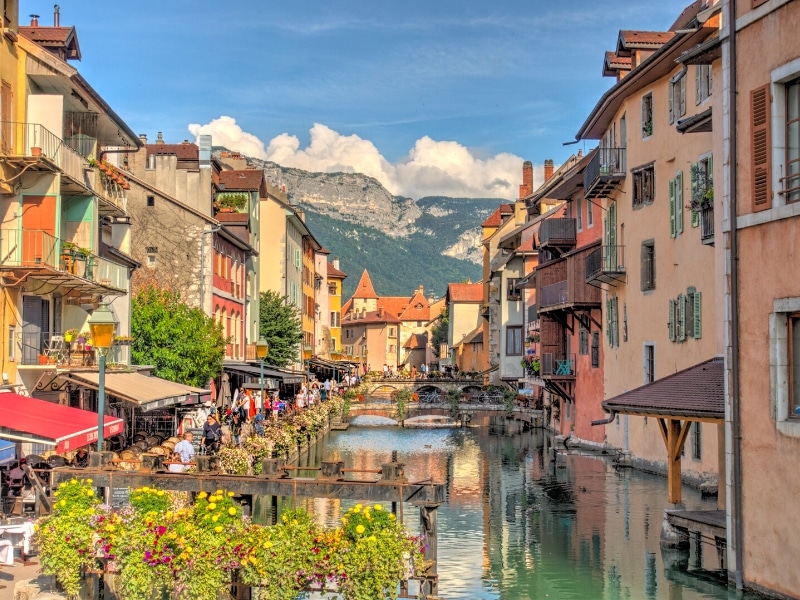
Day 8: Le Grand-Bornand to Thonon-Les-Bains
Col de la Colombière
Located at 5,208 feet / 1,618 meter altitude, the Col de la Colombière is a classic cycle route used many times by the Tour de France.
Between Le Grand-Bornand and the pass is the Mysterious Waterfall, a pretty waterfall on the Nant du Chinaillon that flows down a narrow gorge for about 98 feet / 30 meters. Legend has it that the cascade is the place where the very first couple of Bornandins met.
Cluses
In the heart of the Arve Valley and at the foot of the Alps, Cluses makes a good stop for lunch on the route. There are plenty of choices in what remains of the older part of town but our recommendation would be Le Chalet Gourmand for excellent local food and fantastic service.
If you get time after lunch visit the Musée de l’Horlogerie et du Décolletage and explore Cluses watchmaking history, an industry upon which the modern-day town was built.
Col des Gets
The final pass on your Route des Grandes Alpes road trip, Col des Gets is a baby at just 3,839 feet / 1,170 meters above sea level, and is 12 miles / 19km long, connecting Morzine to the commune of Taninges.
Thonon-les-Bains
Thonon-les-Bains is a beautiful town located on the shores of Lake Geneva, which offers a range of water activities including kayaking and paddleboarding, or just relax on one of the beaches – we like Plage de la Pinède or Plage des Recorts.
The beautiful Jardins de l’Europe park along the lakefront features lush landscaped gardens and walking paths and the Château de Ripaille, a gorgeous 15th century castle with a rich history is worth a visit. Explore the grounds, gardens, and vineyards, and learn about its history and significance in the region.
Follow this up with a visit to the local history museum, Musée du Chablais, to learn about the history, culture, and traditions of the Chablais region.
Enjoy dinner from a mainly local menu at Les Allobroges Bar Restaurant or Gourmandy’s for French and European food.
Upmarket: Hôtel Royal, Évian-les-Bains – Booking.com | Agoda
Mid-Range: Résidence Les Baladines – Booking.com | Agoda
Budget: ibis Thonon Centre – Booking.com | Agoda
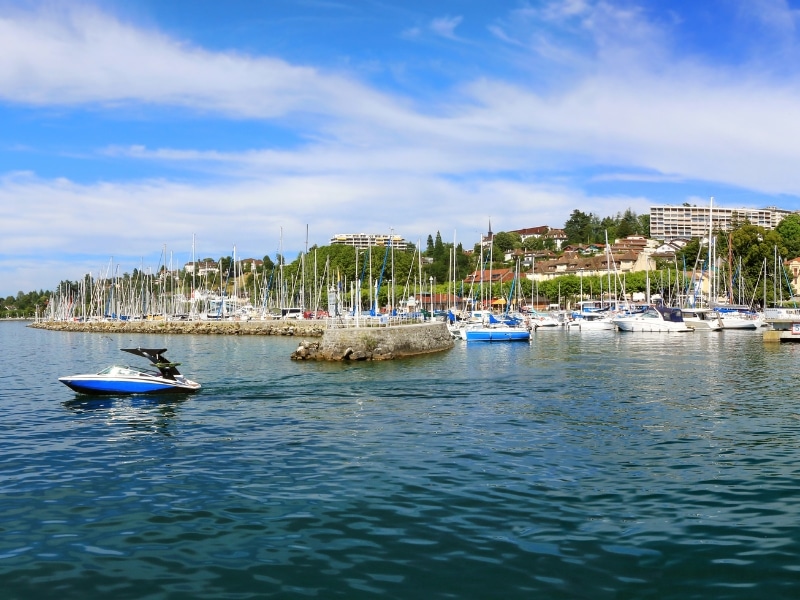
France Road Trip Essentials
Here are the websites and services we personally use and recommend for traveling in France.
Driving in France Tips
Road trips in France are usually pleasurable, thanks to their extensive and well-maintained autoroute network, and generally good local roads. French drivers can be impatient and are dreadful tailgaters and really, really dislike being overtaken, but, c’est la vie, this is France!
Whether you’re traveling in your own car, touring France in a motorhome, or flying in and renting a car, you need to follow these rules when you’re driving in France;
- You must have at least three months remaining on your passport (issued in the past ten years) at your intended date of departure from France.
- You must have at least 3rd party insurance for your vehicle.
- Citizens of non-EU third countries may require an International Driving Permit for driving in Europe. You can check whether you need an IDP here.
- You must carry at least one reflective jacket within the passenger compartment of your vehicle and must put it on before you get out in an emergency or breakdown situation. You must also carry a warning triangle and a first aid kit.
- You may require a Crit’Air sticker which is placed in the windscreen of your vehicle to provide a visible way to identify the level of emissions produced. If you’re renting a vehicle, the Crit’Air sticker should already be on display on the windscreen. Find out more and purchase Crit’Air stickers from the official certificat-air.gouv.fr website.
- French motorways are privately managed and you’re not allowed to request your own assistance company to attend to you if you break down. If you do break down use the orange emergency telephones that are situated every 2km along French motorways to call the police or the official breakdown service operating in that area or dial the emergency services on 112. You will be towed to a safe designated area where you can make onward arrangements for your own breakdown insurer to assist you if you have it. Otherwise, the towing company can provide support or signpost you.
- You do not need to carry a breathalyzer, the law requiring that you do has been repealed.
RELATED POST: Driving in Europe – Everything You Need to Know
Are you looking for more French road trips? Check out these top posts…
France Road Trip – 13 Amazing Itineraries
South of France Road Trip: Route, Highlights & Tips
Normandy Road Trip: Ultimate 7 Day Itinerary
Route Napoleon: A Historic French Road Trip
Driving to France from UK: Absolutely Everything You Need to Know
Motorhoming in France: Your Complete Touring Guide for 2024
Love it? Pin it!

